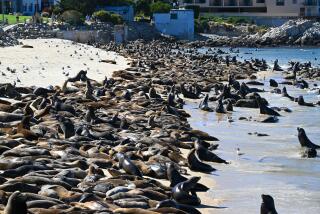Sea Otter Colony Fails to Take Hold on Island : Wildlife: Scientists now say project on San Nicolas will not help save the species, but they stop short of abandoning it.
VENTURA â Five years after embarking on an effort to set up a spinoff colony of California sea otters on San Nicolas Island off the Ventura County coast, scientists say the project is unrealistic and will not help in efforts to save the species from extinction.
But U.S. Fish & Wildlife biologists have stopped short of calling the program a failure--a declaration that would require them to capture the 15 or so otters still living on the island and move them back to the Monterey area.
Since the program began in 1987, 139 otters have been taken to San Nicolas from the Monterey area in hopes they would thrive in a colony on the remote island. Of those, about half swam back to the main colony in the Monterey area. Another 11 have died. Many others are unaccounted for.
Wildlife scientists and members of the Sea Otter Recovery Team, a group of experts assembled from across the nation, say recapturing the remaining animals would be a difficult and stressful process for both divers and animals and not in the best interest of the species.
âWe have a fairly stable group of animals on San Nicolas over the last 2 1/2 years and there has been some reproduction,â said James Estes, a Fish & Wildlife research biologist and member of the Recovery Team. âBut we really donât know yet whether the population will grow on its own or whether it will dwindle to extinction.â
Since 1977, the California sea otter has been classified by federal officials as a species threatened with extinction because of its declining population and susceptibility to man-made disasters such as oil spills. The otters are found in a 220-mile range along the coastline, from Point Ano Nuevo south to Pismo Beach, but most are concentrated off the Monterey County coast.
Estes said he believes biologists should leave the animals on San Nicolas, at least for now, and monitor the small colony for growth. But there are no plans to transfer more animals to the island 60 miles off the Ventura County coast.
In addition, the federal scientists plan to recommend in a report due out later this year that the main group of 2,000 animals off Monterey be free to roam the entire California coastline. Currently, officials attempt to capture otters that move into certain fishing areas.
That suggestion to lift restrictions on their range has angered the commercial fishing industry and alarmed the state Fish and Game Commission. Otters have irritated fisherman by decimating abalone and sea urchin fisheries in the Monterey area.
âOver time, we would lose the entire Channel Islandsâ to otters, assuming they could thrive there, said Steve Rebuck, spokesman for the California Abalone Assn.
State Fish and Game Commissioners, who withdrew support from the program in 1990, plan to call federal scientists on the carpet at a meeting in San Diego on Nov. 5 and 6 for continuing what commissioners consider a failed effort.
âWe need a way to preserve the otters, the shellfish and the commercial industry,â said Albert Taucher, one of the programâs most outspoken critics on the Fish and Game Commission. âI donât know how to do it, but I consider the program a failure and I think everybody should come back to the table.â
The expected clash between the federal and state agencies and the commercial fishing industry at the November commission meeting would be one of many since the controversial biology experiment was conceived in the early 1980s.
But the close of the fifth year of the program, and the expiration of the federal permit to transfer animals to the island, marks several reversals in the positions of many of the parties involved.
First, federal scientists say two things have changed since the infancy of the program: The population of the species, which was static or declining through the 1970s, began a steady rise of 5% a year through the 1980s.
Second, the Exxon Valdez oil spill in Alaska proved to scientists that a small colony of otters, even if it were successful and growing, would not be enough to save a species in the face of such a catastrophic event.
Fish & Wildlife scientists are revising their California Sea Otter Recovery Plan that will for the first time specify the number of otters the main colony should have before the species can be taken off the federal threatened list.
Federal scientists also no longer assert that it is possible to keep the voracious shellfish-eating otters contained on San Nicolas Island and away from nearby commercial fishing beds off the other Channel Islands and elsewhere along the coast.
As a condition of their permit to transfer the animals to San Nicolas, Fish & Wildlife officials promised to capture any otters that swam away from the island and into the so-called no-otter or management zone, which stretches from San Luis Obispo to the Mexican border, excluding a small area around San Nicolas.
Teams of divers assigned to capture otters that stray away from the management zone for return to the Monterey area have so far managed to nab only 15 of the animals in restricted waters. Many more have been sighted, but not caught.
Sea Otter Management
Since 1987, 139 threatened California sea otters have been moved to San Nicolas Island in an effort to set up a colony and save the species from extinction. Biologists must try to capture any animals that stray into the management zone. Scientists now say that the program is ineffective, and may opt to allow the otters to roam the entire coast.
More to Read
Sign up for Essential California
The most important California stories and recommendations in your inbox every morning.
You may occasionally receive promotional content from the Los Angeles Times.










